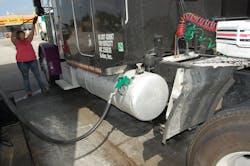Average retail pump prices for both diesel and gasoline continued declining this week, according to data tracked by the Energy Information Administration (EIA), largely because global oil prices continue to drop precipitously.
Diesel declined 7 cents this week to a U.S. average retail pump price of $3.535 per gallon, which is 34.4 cents per gallon cheaper compared to the same week in 2013, EIA reported.
Prices for diesel dropped in all regions of the country this week, with the West Coast recording the steepest decline of 13.2 cents to $3.519 per gallon without including California, the agency said, which translates to a 9.9 cent dip to $3.597 with the Golden State’s diesel prices included.
The Lower Atlantic region is home to the lowest regional diesel price in the nation this week, recording a 4.3 drop to $3.386 per gallon, EIA noted.
Gasoline dipped 9.9 cents this week to a U.S. average retail pump price of $2.679 per gallon, EIA noted, which is 59 cents per gallon cheaper compared to the same week in 2013.
Prices for gasoline fell in every region of the country, dropping the most in the Midwest by 12.9 cents to $2.586 per gallon, followed by: the Rocky Mountain region with a 12.1 cent decline to $2.74 per gallon; New England with a 9.4 cent drop to $2.85 per gallon; and the Gulf Coast with a 9.1 cent dip to $2.440 per gallon, which is also the cheapest regional price for gasoline in the U.S. this week, the agency said.
EIA also reported the amount of proved U.S. oil reserves and lease condensate increased for the fifth year in a row, increasing in 2013 by 9% from the 2012 level to 36.5 billion barrels, according to the agency’s U.S. Crude Oil and Natural Gas Proved Reserves, 2013 report – the first time the nation’s reserves passed the 36 billion barrels since 1975.
North Dakota reported the largest year-over-year increase in oil reserves between 2012 and 2013 – a 51% jump of 1.9 billion barrels – based on development of the Bakken/Three Forks formation in the Williston Basin.
With 5.7 billion barrels of proved reserves, North Dakota has more reserves than the federal offshore waters of the Gulf of Mexico, EIA noted.
Texas remains by far the leading state in total proved oil reserves, increasing 8% from 11.1 billion barrels in 2012 to 12 billion barrels in 2013. By contrast, Alaska reported the largest year-over-year decline of 454 million barrels, due mainly to falling well performance at its large existing oil fields.
EIA added that that increases in crude oil and lease condensate reserves in 2013 resulted mainly from the addition of nearly 5 billion barrels of extensions to existing fields in states such as North Dakota and Texas, the result of additional drilling and exploration in previously discovered reservoirs.
Such additional drilling/exploration accounted for the majority of U.S. reserve increases over the past three years, the agency noted.
About the Author
Sean Kilcarr
Editor in Chief
Sean Kilcarr is a former longtime FleetOwner senior editor who wrote for the publication from 2000 to 2018. He served as editor-in-chief from 2017 to 2018.
